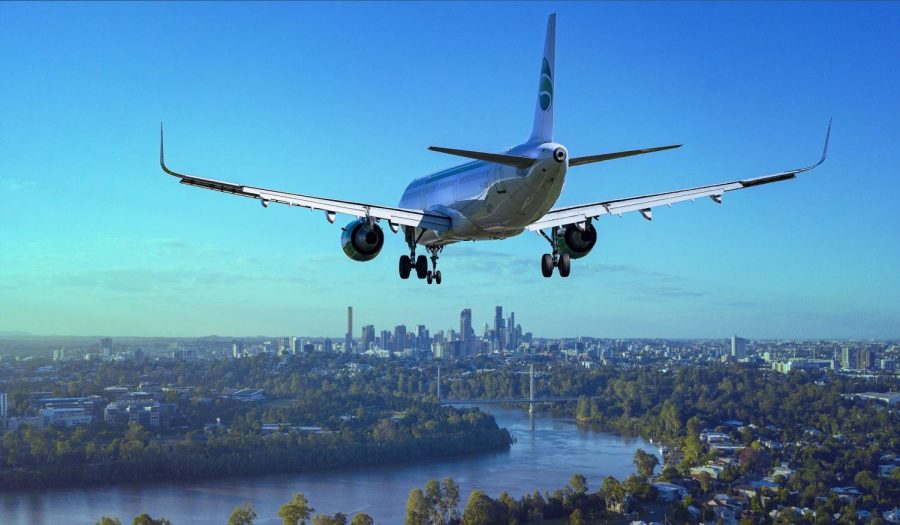Minimizing Air Travel— One of Many Ways to Reduce Carbon Emissions
Airplanes may be mesmerizing to spot up high in the sky, but their harmful consequences on the environment will not be as wondrous.
Global warming is the gradual warming of the overall temperature of the Earth’s atmosphere due to the greenhouse effect caused by carbon emissions and other pollutants, according to Merriam-Webster. Much of global warming is caused by human activities and inventions. Eventually, global warming will lead to the collapse of countless ecosystems, environments, and at some point human life itself.
Many immediately think of recycling as the initial way to help the environment and reduce pollution and therefore global warming. However, there are other ways to help reduce our earth warming. For example, using renewable energy, purchasing energy-efficient appliances, and weathering one’s home by utilizing open windows for air circulation for instance. Some other ways are reducing water waste, ensuring that the food one purchases is going to be used, eaten and not wasted. If this does not happen for whatever reason, research on the process of composting to discover how and what can be composted rather than simply throwing them out. These are just some ways, among many others, to help protect our home.
Air travel is also a major factor in the detrimental release of carbon emissions and evidently, the planet warming. Global warming is no minor feat. The Earth is dying; once again, the Earth is dying. And humans are the cause. People are the spark that ignited the continuous flames that is global warming.
According to the Center for Biological Diversity, due to the altitude of aircrafts, their greenhouse effect, or the gases trapped by the sun’s warmth in the atmosphere, aircrafts can continue to pollute the air for years after their flight. If not dealt with, air travel will release about 43 metric gigatons of carbon dioxide by 2050. This massive release of CO2 will end up contributing to around 5% of global emissions— therefore weakening the ozone layer. A depleting ozone layer will cause a range of health problems. Some such health complications are skin cancers and difficulties for those with respiratory issues. As stated by the David Suzuki Foundation, not engaging in a single flight is like going car-free for a year.
However, there are reasons why many enjoy or prefer to travel by airplane. Air travel is inarguably quicker than, say, travel by ship. A flight from New York to London takes around seven hours. Meanwhile, a trip by boat can typically take six to seven days for transit. Similarly, air travel is significantly less costly than water travel. A New York to London flight costs less than $1 thousand, yet a cruise is two to three times as much.
Despite this, the cost of inaction on the planet cannot be measured in any form of currency.
There are other, more simple ways to make air travel more environmentally friendly as well. The most obvious is attempting to take flights when only absolutely necessary, as well as taking direct, non-stop flights. Also, only fly economy, because it maximizes the number of passengers per flight, which means no space is wasted on seating and fewer flights are sent out. One should also choose an airline carefully for the quality of the plane, as well as other smaller aspects that may be environmentally friendly. Some such examples are the type of fuel, the materials of the plane itself, what is used to make physical advertisements, and many more.
One final additional environmentally beneficial way to approach air travel is to offset flights with carbon credits. According to SouthPole.com, carbon credits can be purchased by companies or individuals to support a project that reduces carbon impact in the atmosphere. Some examples of projects that qualify include planting trees, building wind farms and improving energy efficiency. These projects are monitored and must prove that they provide a permanent environmental benefit. If a company can not reduce their carbon footprint through the purchasing of carbon credits, they are a company to use.
Preserving the environment is required for all life on Earth to go on. It is important to think about the future of one’s friends, family, and posterity. Climate change may seem slow-coming and it may not affect this generation much, but as each year passes, the effects of global warming gradually increase. If nothing is done about it, the situation will continue to worsen. There is not just one solution— there are many ways, small and large, that can lead to a decrease in warming temperatures.
We as a collective people and humanity have a responsibility to protect and conserve our home. Reducing or completely stopping air travel is but one factor that will help. There is only humanity. There is only one Earth. There is no planet B.

Sam Stokem is a senior at LRHS and is writing for the Lancer Ledger for their third year in a row. They are glad to continue to inform people about the...












